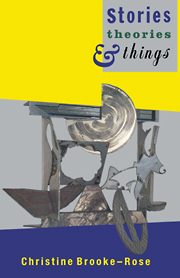Book contents
- Frontmatter
- Contents
- Preface
- Acknowledgements
- Part I Theories as stories
- Part II Stories and style
- 4 A for but: Hawthorne's ‘The Custom-House’
- 5 Ill locutions
- 6 Ill logics of irony
- 7 Ill wit and sick tragedy
- 8 Cheng Ming Chi'I'd
- 9 Notes on the metre of Auden's The Age of Anxiety
- Part III Theories of stories
- Part IV Things?
- References
- Index
4 - A for but: Hawthorne's ‘The Custom-House’
Published online by Cambridge University Press: 20 August 2009
- Frontmatter
- Contents
- Preface
- Acknowledgements
- Part I Theories as stories
- Part II Stories and style
- 4 A for but: Hawthorne's ‘The Custom-House’
- 5 Ill locutions
- 6 Ill logics of irony
- 7 Ill wit and sick tragedy
- 8 Cheng Ming Chi'I'd
- 9 Notes on the metre of Auden's The Age of Anxiety
- Part III Theories of stories
- Part IV Things?
- References
- Index
Summary
Antithesis has much in common with metaphor in that it brings together, by juxtaposition, two entities normally separated by an opposition like a wall, and Barthes describes it just so in his analysis of what he calls the rhetorical entry into his Symbolic Code: the Symbolic is the magical moment when the wall crumbles, when for example age and youth, the monstrously effeminate male and innocently strong female have briefly come together to form a chimerical creature, then spring apart at a touch (1974, 65). We may compare this notion of a wall with the metaphor of the ruined wall towards the end of The Scarlet Letter, where the soul is a citadel once breached by guilt, well guarded ‘so that the enemy shall not force his way again […] But there is still the ruined wall, and, near it, the stealthy tread of the foe that would win over again his unforgotten triumph’ (144). This metaphor can also extend from good and evil to the way antithesis functions.
The soul as citadel is a very old metaphor, though usually the building is rather the body that houses the soul. The psyche as house is familiar to psychoanalysts. Many critics have remarked on the novel's opening, where Hester Prynne emerges from the prison in seventeenth-century Boston, and its prefiguring by the author in his nineteenth-century Custom-House in Salem. What has not been explored is the unusualness of having a Custom-House at all in this opening role of hostel for the psyche, for the author's imagination.
- Type
- Chapter
- Information
- Stories, Theories and Things , pp. 47 - 62Publisher: Cambridge University PressPrint publication year: 1991



